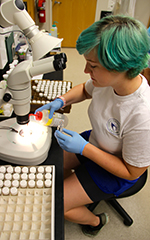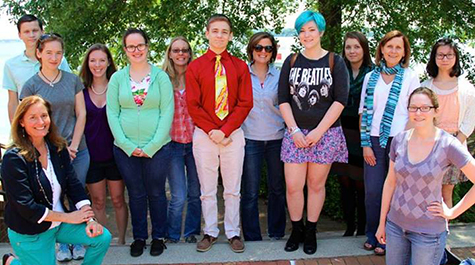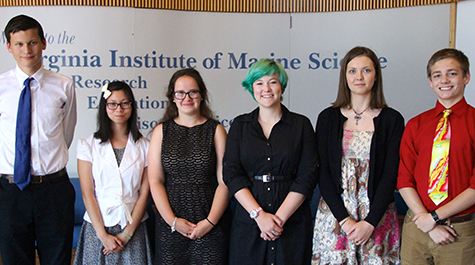Governor’s School students complete summer apprenticeships
Six high school students from throughout the Commonwealth completed summer research projects on July 18th as part of the Governor’s School program at the Virginia Institute of Marine Science.
The students gained hands-on experience in the lab and field through projects focused on everything from the environmental impacts of commercial clam farming, to the relatedness of sailfish populations in the Atlantic and Indo-Pacific oceans and the influence of oyster-reef complexity on habitat selection by mud crabs.
The VIMS Governor's School is a 4-week summer program that has been providing high-achieving high school students with authentic experiences in marine research since 1993. Each summer, VIMS hosts up to 6 students who have demonstrated interest in and aptitude for marine science. The program is administered in tandem with a similar program at NASA Langley.
VIMS Research Associate Professor Rochelle Seitz, who has served as director of the program since 2005, says the apprenticeships offer a wide variety of research opportunities. “Each student’s experience is as different as their mentors’ research interests,” she says. “What they all gain is a deeper understanding of their specific project and a greater appreciation for the challenges and rewards of marine research.”
Jack Huguenin, a rising junior at Central High School in Wise, was mentored by Seitz and graduate student Melissa Karp. Their project was to observe whether the size and shape of an oyster reef might influence habitat selection by mud crabs.
“Melissa and I designed artificial oyster reefs controlling specific dimensional measurements,” he says. “We dispensed mud crabs into plastic trays containing a high and low artificial reef exhibiting a particular measurement, and then we emptied the trays to see which reef had more mud crabs.”
Joining Huguenin in the VIMS program were Kristin Choi (Ocean Lakes High School, Virginia Beach); Ellie Grace (Potomac Falls High School, Loudon County); Kelly Salyer (John S. Battle High School, Bristol); Jessica Sydnor (Poquoson High School, Poquoson); and Nicklaus Wohler (Riverbend High School, Fredricksburg).
Sydnor, a rising senior, worked with VIMS professor Courtney Harris and graduate student Danielle Smith, using the Regional Ocean Modeling System (ROMS) and MATLAB to improve hydrodynamic modeling of salinity dynamics in the York River.
“My future goal is to become either a mathematician or chemist that works within the field of marine science,” says Syndor. “My new-found familiarity with MATLAB will prove to be a very useful tool in my future career.”
Grace, who attends the Loudon Academy of Science in Northern Virginia in addition to Potomac Falls High School, hopes to double major in environmental science and graphic design when she heads off to college.
“I’ve never been able to pinpoint my favorite field of science,” says Grace. “I hope my future career allows me to dabble in the different fields of science that I have a deep interest in, which are marine science, physics, and mathematics.”
Mentored by VIMS Professor Iris Anderson and graduate student Annie Murphy, Grace worked on a project to determine if commercial clam farming impacts the diversity of organisms that burrow within underlying sediments. “Essentially, we calculated biodiversity indices for the organisms found within sediment core samples, then compared those indices for cores retrieved from areas within clam beds and in bare sediment to see if clam farming does indeed affect the infaunal communities.”
Salyer, a rising senior, has set her sights on a career in marine science. “Marine science is such an exciting field with ever-developing opportunities, so I definitely plan to further my research in marine biology after high school,” she says.
Salyer, who was mentored by Professor Elizabeth Canuel and graduate student Amanda Knobloch, compared the physical and chemical parameters of carbon pools in Taskinas Creek—a reserve within the boundaries of York River State Park. “Being a Governor’s School student at VIMS taught me how important estuaries are to our ecosystem,” she says. “I learned important relationship and life skills, as well as the importance of responsibilities and how your life is forever influenced by the responsibilities you choose to take on.”
Choi describes her experience at VIMS as a “truly edifying and amazing one.” “Through my mentorship, I was able to partake in a lot of activities that opened my eyes to what it’s like to be a marine biologist—from getting wet and dirty to sifting through mud samples of macroinvertebrates.”
Choi, a rising junior in the Math and Science Academy at her high school, plans to continue on to college to further peruse her fields of interest: biology, math, engineering, and marine biology.
Mentored by Professor Rom Lipcius and graduate student Megan Wood, Choi helped conduct a survey of Gracilaria—a type of red algae—in the York River. “The objective of the project was to identify any significant trends that appeared over the past year in relation to the Gracilaria,” she says. “Since it’s currently undeterminable whether Gracilaria vermiculophylla is an invasive species in the York River, it’s essential that scientists continue to monitor the effects that it has on the ecosystem of the river. “
Wohler, who was mentored by Research Assistant Professor Jan McDowell, Lab and Research Specialist Heidi Brightman, and graduate student Nadya Mamoozadeh, completed a comparison of sailfish populations in the Atlantic and Indo-Pacific oceans based on analysis of their genetic code—specifically the repeating sequences of DNA called microsatellites that can be used to compare the degree of relatedness between different species.
With their high school careers coming to an end, Grace, Huguenin, and Sydnor are all considering pursuing their undergraduate degrees at the College of William & Mary.
“This program is important for the students to gain hands-on experience in marine science research so that they can better determine whether this is a discipline they would like to pursue for a career,” says Seitz. “Some of our past Governor's School students have even gone on to apply to the College of William & Mary’s School of Marine Science at VIMS.”



